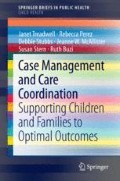Abstract
Home visitation programs have been identified as an effective approach to address the health care needs of women and children. The focus of home visitation programs on longitudinal and comprehensive care is consistent with case management approaches. Several models of home visitation programs have been implemented in the country. While they vary in focus, they all focus on enhancing family and child outcomes. There is substantial evidence that suggests that home visitation programs are effective in improving maternal and child outcomes. Several elements have been identified as effective in enhancing outcomes and should be considered in planning home visitation programs. The relationship between the home visitor and the family is crucial to the success of the program. Home visitation programs should be family-centered and address the unique needs of the families served.
Access this chapter
Tax calculation will be finalised at checkout
Purchases are for personal use only
References
American Academy of Pediatrics, Council on Child and Adolescent Health. (1998). The role of home-visitation programs in improving health outcomes for children and families. Pediatrics, 101(3 Pt 1), 486–489.
Davis, D. W., Jones, V. F., Logsdon, M. C., Ryan, L., & Wilkerson-McMahon, M. (2013). Health promotion in pediatric primary care: Importance of health literacy and communication practices. Clinical Pediatrics (Phila), 52(12), 1127–1134. doi:10.1177/0009922813506607.
Dunst, C. J., Johanson, C., Trivette, C. M., & Hamby, D. (1991). Family-oriented early intervention policies and practices: Family-centered or not? Exceptional Children, 58(2), 115–126.
Fazzone, P. A., Barloon, L. F., McConnell, S. J., & Chitty, J. A. (2000). Personal safety, violence, and home health. Public Health Nursing, 17(1), 43–52.
Goyal, N. K., Teeters, A., & Ammerman, R. T. (2013). Home visiting and outcomes of preterm infants: A systematic review. Pediatrics, 132(3), 502–516. doi:10.1542/peds.2013-0077.
Healthy Families America. (2014). About us: Overview. From http://www.healthyfamiliesamerica.org/about_us/index.shtml.
Holland, M. L., Christensen, J. J., Shone, L. P., Kearney, M. H., & Kitzman, H. J. (2014). Women’s reasons for attrition from a nurse home visiting program. Journal of Obstetric, Gynecologic, and Neonatal Nursing, 43(1), 61–70. doi:10.1111/1552-6909.12263.
Issel, L. M., Forrestal, S. G., Slaughter, J., Wiencrot, A., & Handler, A. (2011). A review of prenatal home-visiting effectiveness for improving birth outcomes. Journal of Obstetric, Gynecologic, and Neonatal Nursing, 40(2), 157–165. doi:10.1111/j.1552-6909.2011.01219.x.
Love, J. M., Kisker, E. E., Ross, C., Raikes, H., Constantine, J., Boller, K., et al. (2005). The effectiveness of early head start for 3-year-old children and their parents: lessons for policy and programs. Developmental Psychology, 41(6), 885–901. doi:10.1037/0012-1649.41.6.88.
McCurdy, K. (2005). The influence of support and stress on maternal attitudes. Child Abuse and Neglect, 29(3), 251–268. doi:10.1016/j.chiabu.2004.12.007.
Nadwairski, J. A. (1992). Inner-city safety for home care providers. Journal of Nursing Administration, 22(9), 42–47.
National Healthy Start Association. (2014). Retrieved July 1, from http://www.nationalhealthystart.org/
Nurse-Family Partnership. (2014). Retrieved July 1, from http://www.nursefamilypartnership.org/
O’Brien, R. A., Moritz, P., Luckey, D. W., McClatchey, M. W., Ingoldsby, E. M., & Olds, D. L. (2012). Mixed methods analysis of participant attrition in the nurse-family partnership. Prevention Science, 13(3), 219–228. doi:10.1007/s11121-012-0287-0.
Olds, D. (1992). Home visitation for pregnant women and parents of young children. American Journal of Diseases of Children, 146(6), 704–708.
Olds, D., Henderson, C. R, Jr, Kitzman, H., & Cole, R. (1995). Effects of prenatal and infancy nurse home visitation on surveillance of child maltreatment. Pediatrics, 95(3), 365–372.
Parents as Teachers. (2014). Retrieved 2014, from http://www.parentsasteachers.org/about.
Peacock, S., Konrad, S., Watson, E., Nickel, D., & Muhajarine, N. (2013). Effectiveness of home visiting programs on child outcomes: A systematic review. BMC Public Health, 13, 17. doi:10.1186/1471-2458-13-17.
Raikes, H., Green, B. L., Atwater, J., Kisker, E., Constantine, J., & Chazan-Cohen, R. (2006). Involvement in Early Head Start home visiting services: Demographic predictors and relations to child and parent outcomes. Early childhood Research Quarterly, 21, 2–24.
Smith, S. A., & Moore, E. J. (2012). Health literacy and depression in the context of home visitiation. Maternal and Child Health Journal, 16, 1500–1508.
Smithbattle, L., Lorenz, R., & Leander, S. (2013). Listening with care: Using narrative methods to cultivate nurses’ responsive relationships in a home visiting intervention with teen mothers. Nursing Inquiry, 20(3), 188–198. doi:10.1111/j.1440-1800.2012.00606.x.
Strom, A., Kvernbekk, T., & Fagermoen, M. S. (2011). Parity: (im) possible? Interplay of knowledge forms in patient education. Nursing Inquiry, 18(2), 94–101. doi:10.1111/j.1440-1800.2011.00517.x.
U.S. Department of Health and Human Serivces. (2013). Home visiting evidence of effectiveness. Retrieved 2014, from http://homvee.acf.hhs.gov/Default.aspx.
Wagner, M., Spiker, D., & Linn, M. I. (2002). The effectiveness of the Parents as Teachers program with low-income parents and children. TECSE, 22(2), 67–81.
Wasik, B. H., Bryan, D. M., & Lyons, C. M. (1990). Home visiting: procedures for helping families. Newbury Park, California: Sage Publications.
Weiss, H. B. (1993). Home visits: Necessary but not sufficient. Future of Children, 3, 113–128.
Zeanah, P. D., Larrieu, J. A., Boris, N. W., & Nagle, G. (2006). Nurse home visiting: Perspecitives from nurses. Infant Mental Health Journal, 27, 41–54.
Author information
Authors and Affiliations
Corresponding author
Rights and permissions
Copyright information
© 2015 The Author(s)
About this chapter
Cite this chapter
Treadwell, J. (2015). Home Visitation and Care Coordination. In: Case Management and Care Coordination. SpringerBriefs in Public Health(). Springer, Cham. https://doi.org/10.1007/978-3-319-07224-1_7
Download citation
DOI: https://doi.org/10.1007/978-3-319-07224-1_7
Published:
Publisher Name: Springer, Cham
Print ISBN: 978-3-319-07223-4
Online ISBN: 978-3-319-07224-1
eBook Packages: Behavioral ScienceBehavioral Science and Psychology (R0)

